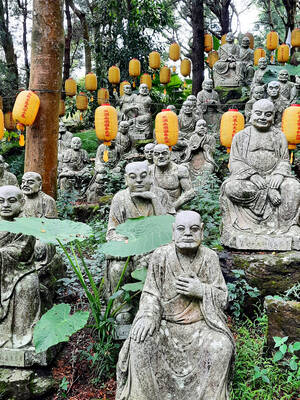Mention xiaolongbao (小龍包), or steamed dumplings, and the name Din Tai Fung (鼎泰豐) is bound to enter the conversation. But any dumpling aficionado is just as likely to tout a cheaper and even better alternative.
One such place is Mingyue Tangbao (明月湯包, Mingyue Steamed Dumplings), which enjoys a loyal following. During busy times it’s not uncommon to find a line of people waiting outside this modest shop near the Tonghua Street (通化街) night market. The interior feels more like the typical Taiwanese noodle joint, sparsely decorated and with room for about 20 people. Wooden blocks on the wall list each menu item, and medals won by the chef hang proudly at the back of the room.
Both connoisseurs and newcomers should try the house specialty, mingyue tangbao (明月湯包, NT$120 per basket of eight), the shop’s name for its xiaolongbao. The marks of a good dumpling were all there: the outer flour wrap was delicate and thin but didn’t break when picked up with chopsticks; each dumpling had a good proportion of soup, meat and dough; and the minced pork was lean and tasted fresh.
There are different ways to enjoy xiaolongbao, which is part of the fun. Some like to eat a whole dumpling in one bite and let the broth trapped inside explode in the mouth (let the dumplings cool for a few minutes so you won’t burn yourself). A slower method is to savor the flavors separately. Dip a dumpling in soy sauce and vinegar, place it in your spoon, nibble a hole in the wrap and sip the soup that spills out. Finish the rest after adding a few slithers of ginger, which the waiter brings to your table on a tiny sauce plate.
Mingyue’s unique pot stickers (鍋貼, NT$120), also a house specialty, could rekindle affection for this old standby. Each serving of 10 dumplings arrives connected together at the bottom by a thin golden sheet of crispy flour and oil. The waiter sets the plate down and quickly separates the dumplings with a fork. The crispy bottom packed a satisfying crunch while a hint of sweetness in the dough was well-balanced by the minced pork’s savoriness.
The steamed vegetable dumplings (淨素蒸餃, NT$130 per basket of eight) also deserve mention for their tasty filling of vegetable greens and bits of tofu. Some heartier choices for winter include the steamed chicken soup (圓盅燉雞湯, NT$140) and the stewed beef soup (清燉牛肉湯, NT$120), both of which come with a side of noodles for an extra NT$20. Pass on the scallion pancakes (蔥油餅, NT$50), which were too greasy.
Mingyue also runs a more spacious sit-down restaurant around the corner at 40, Ln 171, Tonghua St (通化街171巷40號), with a wider range of options, but its faux trendy decor falls short. The plain-Jane shop on Keelung Road has more character, if you can do without the Shanghai grandeur. Both restaurants are a five-minute walk from Liuzhangli (六張犁) MRT Station. — DAVID CHEN

President William Lai (賴清德) has championed Taiwan as an “AI Island” — an artificial intelligence (AI) hub powering the global tech economy. But without major shifts in talent, funding and strategic direction, this vision risks becoming a static fortress: indispensable, yet immobile and vulnerable. It’s time to reframe Taiwan’s ambition. Time to move from a resource-rich AI island to an AI Armada. Why change metaphors? Because choosing the right metaphor shapes both understanding and strategy. The “AI Island” frames our national ambition as a static fortress that, while valuable, is still vulnerable and reactive. Shifting our metaphor to an “AI Armada”

When Taiwan was battered by storms this summer, the only crumb of comfort I could take was knowing that some advice I’d drafted several weeks earlier had been correct. Regarding the Southern Cross-Island Highway (南橫公路), a spectacular high-elevation route connecting Taiwan’s southwest with the country’s southeast, I’d written: “The precarious existence of this road cannot be overstated; those hoping to drive or ride all the way across should have a backup plan.” As this article was going to press, the middle section of the highway, between Meishankou (梅山口) in Kaohsiung and Siangyang (向陽) in Taitung County, was still closed to outsiders

The older you get, and the more obsessed with your health, the more it feels as if life comes down to numbers: how many more years you can expect; your lean body mass; your percentage of visceral fat; how dense your bones are; how many kilos you can squat; how long you can deadhang; how often you still do it; your levels of LDL and HDL cholesterol; your resting heart rate; your overnight blood oxygen level; how quickly you can run; how many steps you do in a day; how many hours you sleep; how fast you are shrinking; how

US President Donald Trump may have hoped for an impromptu talk with his old friend Kim Jong-un during a recent trip to Asia, but analysts say the increasingly emboldened North Korean despot had few good reasons to join the photo-op. Trump sent repeated overtures to Kim during his barnstorming tour of Asia, saying he was “100 percent” open to a meeting and even bucking decades of US policy by conceding that North Korea was “sort of a nuclear power.” But Pyongyang kept mum on the invitation, instead firing off missiles and sending its foreign minister to Russia and Belarus, with whom it